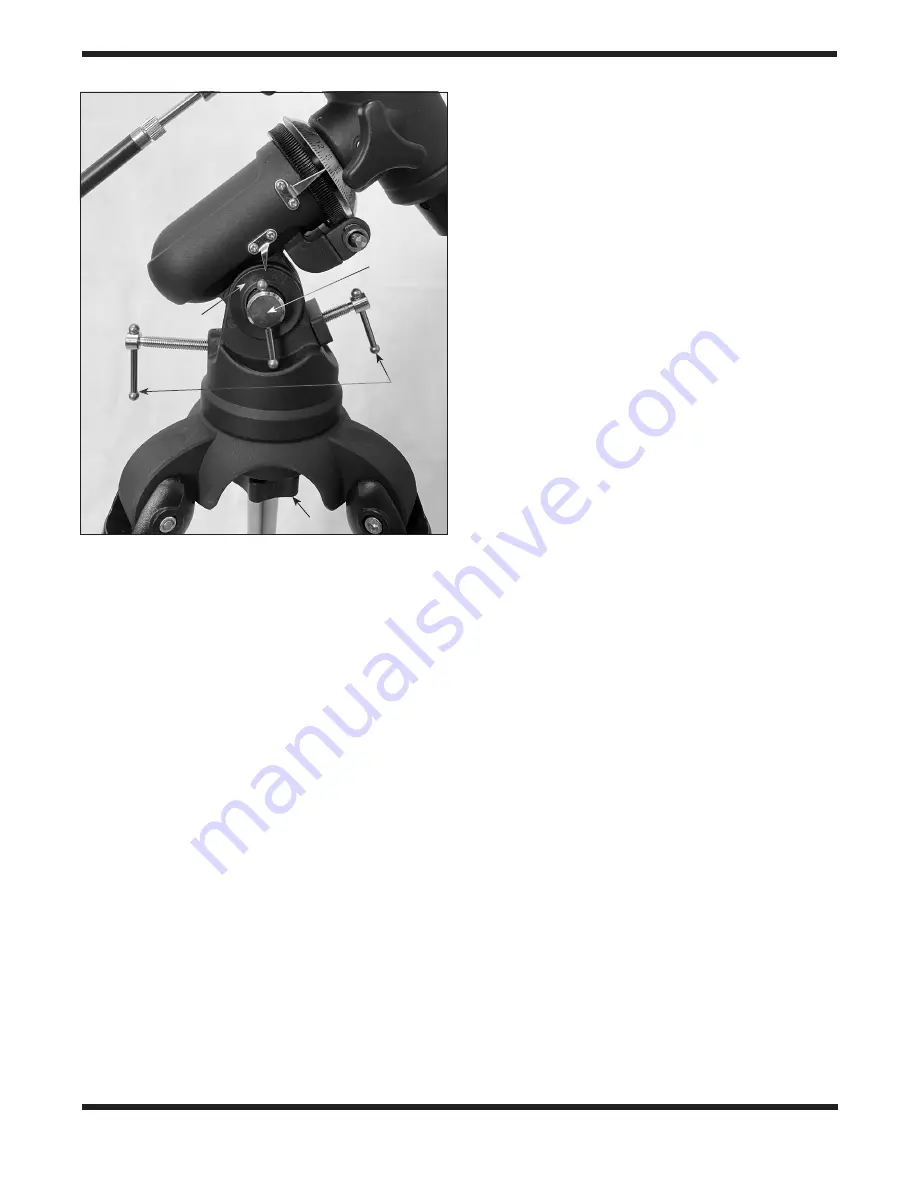
7
Turn the power knob (see
Figure 10
) clockwise until you hear
the "click" indicating that power has been turned on. Look
through the back of the reflex sight with both eyes open to see
the red dot. Position your eye at a comfortable distance from
the back of the sight. In daylight you may need to cover the
front of the sight with your hand to be able to see the dot, which
is purposefully quite dim. The intensity of the dot is adjusted by
turning the power knob. For best results when stargazing, use
the dimmest possible setting that allows you to see the dot
without difficulty. Typically a dimmer setting is used under dark
skies and a bright setting is used under light-polluted skies or
daylight.
At the end of your observing session, be sure to turn the power
knob counterclockwise until it clicks off. When the two white
dots on the EZ Finder II's rail and power knob are lined up, the
EZ Finder II is turned off.
Aligning the EZ Finder II
When the EZ Finder II is properly aligned with the telescope,
an object that is centered on the EZ Finder II's red dot should
also appear in the center of the field of view of the telescope's
eyepiece. Alignment of the EZ Finder II is easiest during day-
light, before observing at night. Aim the telescope at a distant
object such as a telephone pole or roof chimney and center it
in the telescope's eyepiece. The object should be at least 1/2
mile away. Now, with the EZ Finder turned on, look through the
EZ Finder II. The object will appear in the field of view near the
red dot.
Without moving the main telescope, use the EZ Finder II's azi-
muth (left/right) and altitude (up/down) adjustment knobs (see
Figure 10
) to position the red dot on the object in the eyepiece.
When the red dot is centered on the distant object, check to
make sure that the object is still centered in the telescope's
field of view. If not, recenter it and adjust the EZ Finder II's
alignment again. When the object is centered in the eyepiece
and on the EZ Finder's red dot, the EZ Finder II is properly
aligned with the telescope.
Replacing the Battery
Should the battery ever die, replacement 3-volt lithium bat-
teries are available from many retail outlets. Remove the old
battery by inserting a small flat-head screwdriver into the slot
on the battery casing (
Figure 10
) and gently prying open the
case. Then carefully pull back on the retaining clip and remove
the old battery. Do not overbend the retaining clip. Then slide
the new battery under the battery lead with the positive (+) end
facing the retaining clip (outward) and replace the battery cas-
ing.
Once aligned, EZ Finder II will usually hold its alignment even
after being removed and remounted. Otherwise, only minimal
realignment will be needed.
VI. Polar Alignment
When you look at the night sky, you no doubt have noticed the
stars appear to move slowly from east to west over time. That
apparent motion is caused by the Earth’s rotation (from west to
east). An equatorial mount is designed to compensate for that
motion, allowing you to easily “track” the movement of astro-
nomical objects, thereby keeping them from drifting out of the
telescope’s field of view while you’re observing.
This is accomplished by slowly rotating the telescope on its
right ascension (R.A.) axis, using only the R.A. slow-motion
cable. But first the R.A. axis of the mount must be aligned
with the Earth’s rotational (polar) axis—a process called polar
alignment.
For Northern Hemisphere observers, approximate polar align-
ment is achieved by pointing the mount’s right ascension axis
at the North Star, also known as Polaris (see
Figure 11
)
.
It lies
within 1° of the north celestial pole (NCP), which is an exten-
sion of the Earth’s rotational axis out into space. Stars in the
Northern Hemisphere appear to revolve around the NCP.
To find Polaris in the sky, look north and locate the pattern
of the Big Dipper (
Figure 11
). The two stars at the end of the
“bowl” of the Big Dipper point approximately to Polaris.
Observers in the Southern Hemisphere aren’t so fortunate to
have a bright star so near the south celestial pole (SCP). The
star Sigma Octantis lies about 1° from the SCP, but it is barely
visible with the naked eye (magnitude 5.5).
To polar align the equatorial mount:
1. Roughly level the mount by adjusting the length of the three
tripod legs as needed (
Figure 12
).
2. Loosen the latitude lock knob a half turn or so (
Figure 13
).
3. Using the two latitude adjustment T-bolts, set the latitude so
that the pointer on the latitude scale indicates the latitude
of your observing location. (Loosen one latitude adjustment
Figure 13.
Loosen the latitude lock knob, then use the two latitude
adjustment T-bolts to set the latitude scale pointer to your location’s
latitude.
Latitude scale
Mount attachment knob
Latitude lock
knob
Latitude
adjustment
T-bolts
























